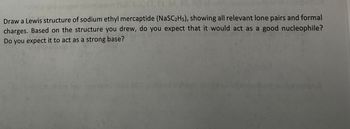
Chemistry
10th Edition
ISBN: 9781305957404
Author: Steven S. Zumdahl, Susan A. Zumdahl, Donald J. DeCoste
Publisher: Cengage Learning
expand_more
expand_more
format_list_bulleted
Concept explainers
Question

Transcribed Image Text:Draw a Lewis structure of sodium ethyl mercaptide (NaSC2H5), showing all relevant lone pairs and formal
charges. Based on the structure you drew, do you expect that it would act as a good nucleophile?
Do you expect it to act as a strong base?
Expert Solution
This question has been solved!
Explore an expertly crafted, step-by-step solution for a thorough understanding of key concepts.
Step by stepSolved in 3 steps with 2 images

Knowledge Booster
Learn more about
Need a deep-dive on the concept behind this application? Look no further. Learn more about this topic, chemistry and related others by exploring similar questions and additional content below.Similar questions
- 4a. Which type of molecule is this? Label the nonpolar and polar regions of this molecule. Label the ester bonds and phosophodiester bonds. H₂C-0-C HC-0-C CH, CH,−N O CH₂ O CH3 4b. What products would you obtain if you performed an hydrolysis reaction? Draw them. O=C O=0arrow_forwardAfter the saponification reaction, but before the neutralization of the reaction mixture with H₂SO4, the product is a salt of salicylic acid. Draw the structure of this salt, clearly showing the formal charges.arrow_forwardLook at the atom in each molecule and classify as an electrophile or a nucleophile. How do you know if it is a electrophile or nucleophile? What makes it an electro or nucleophile? C in CH3Br N in NH3 O in HO-arrow_forward
- complete the reaction. what are products A, B, and C?arrow_forwardWhy does the dehydration of an alcohol more often use concentrated sulfuric acid, H2SO4H2SO4, as the acid catalyst rather than dilute hydrochloric acid, HCl? Select one or more: Hydrochloric acid is too small to effectively react with the alcohol in the reaction. The additional water solvent from a dilute solution could reverse the dehydration reaction. Only acids with more than one proton can complete the dehydration reaction. The presence of the chloride ion could result in a competing substitution reaction.arrow_forwardDraw the structure that would result from the reactionsarrow_forward
- Predict the product(s) of the following acid/base reactions. Draw curved arrows to show the formation and breaking of bonds. BF 3arrow_forwardE CH3 الملا Cat - Os Oy Mez NO -CH₂ Acetone; H₂₂0 7arrow_forwardDraw 2‑methylpropanal. Include all hydrogen atoms. Predict the products when cyclohexanol is heated in the presence of H+.H+. Show all hydrogen atoms.arrow_forward
- OH 1. NaOH, EtOH 2. n-BuBr A nucleophilic substitution reaction is a frequently used method to convert one functional group into another. A nucleophile is mixed with an electrophile and the nucleophile replaces the leaving group to produce a new compound. In this experiment, a weak nucleophile (2-naphthol) is converted into a strong nucleophile by deprotonation with sodium hydroxide. Then this strong nucleophile, now with a negative charge, reacts with alkyl halide to yield an ether, 2-butoxynaphthalene. 2-butoxynaphthalene is a flavoring agent that has strong fruit smell like raspberry and strawberry.arrow_forwardDraw the organic product you would expect to isolate from the nucleophilic substitution reaction between the molecules shown. Note: You do not need to draw any of the side products of the reaction, only the substitution product. □ + HO 1 + X S Click and drag to start drawing a structure.arrow_forwardx ✓5 Br 6 Draw the organic product you would expect to isolate from the nucleophilic substitution reaction between the molecules shown. Note: You do not need to draw any of the side products of the reaction, only the substitution product. Ö + X S 8 C 9 Click and drag to start drawing a structure. 10arrow_forward
arrow_back_ios
SEE MORE QUESTIONS
arrow_forward_ios
Recommended textbooks for you
 ChemistryChemistryISBN:9781305957404Author:Steven S. Zumdahl, Susan A. Zumdahl, Donald J. DeCostePublisher:Cengage Learning
ChemistryChemistryISBN:9781305957404Author:Steven S. Zumdahl, Susan A. Zumdahl, Donald J. DeCostePublisher:Cengage Learning ChemistryChemistryISBN:9781259911156Author:Raymond Chang Dr., Jason Overby ProfessorPublisher:McGraw-Hill Education
ChemistryChemistryISBN:9781259911156Author:Raymond Chang Dr., Jason Overby ProfessorPublisher:McGraw-Hill Education Principles of Instrumental AnalysisChemistryISBN:9781305577213Author:Douglas A. Skoog, F. James Holler, Stanley R. CrouchPublisher:Cengage Learning
Principles of Instrumental AnalysisChemistryISBN:9781305577213Author:Douglas A. Skoog, F. James Holler, Stanley R. CrouchPublisher:Cengage Learning Organic ChemistryChemistryISBN:9780078021558Author:Janice Gorzynski Smith Dr.Publisher:McGraw-Hill Education
Organic ChemistryChemistryISBN:9780078021558Author:Janice Gorzynski Smith Dr.Publisher:McGraw-Hill Education Chemistry: Principles and ReactionsChemistryISBN:9781305079373Author:William L. Masterton, Cecile N. HurleyPublisher:Cengage Learning
Chemistry: Principles and ReactionsChemistryISBN:9781305079373Author:William L. Masterton, Cecile N. HurleyPublisher:Cengage Learning Elementary Principles of Chemical Processes, Bind...ChemistryISBN:9781118431221Author:Richard M. Felder, Ronald W. Rousseau, Lisa G. BullardPublisher:WILEY
Elementary Principles of Chemical Processes, Bind...ChemistryISBN:9781118431221Author:Richard M. Felder, Ronald W. Rousseau, Lisa G. BullardPublisher:WILEY

Chemistry
Chemistry
ISBN:9781305957404
Author:Steven S. Zumdahl, Susan A. Zumdahl, Donald J. DeCoste
Publisher:Cengage Learning

Chemistry
Chemistry
ISBN:9781259911156
Author:Raymond Chang Dr., Jason Overby Professor
Publisher:McGraw-Hill Education

Principles of Instrumental Analysis
Chemistry
ISBN:9781305577213
Author:Douglas A. Skoog, F. James Holler, Stanley R. Crouch
Publisher:Cengage Learning

Organic Chemistry
Chemistry
ISBN:9780078021558
Author:Janice Gorzynski Smith Dr.
Publisher:McGraw-Hill Education

Chemistry: Principles and Reactions
Chemistry
ISBN:9781305079373
Author:William L. Masterton, Cecile N. Hurley
Publisher:Cengage Learning

Elementary Principles of Chemical Processes, Bind...
Chemistry
ISBN:9781118431221
Author:Richard M. Felder, Ronald W. Rousseau, Lisa G. Bullard
Publisher:WILEY